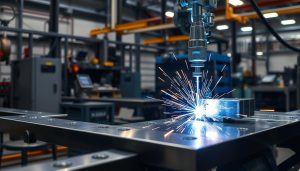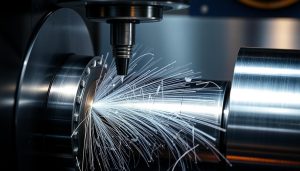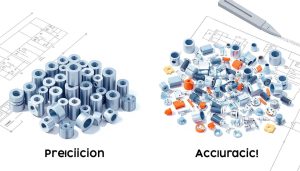In the realm of manufacturing and construction, the distinction between metal milling and wood milling is crucial. These two processes, while similar in some ways, present unique challenges and considerations that must be addressed to ensure a safe and efficient work environment. This article delves into the key differences between metal and wood milling, highlighting the importance of understanding material-specific safety protocols, proper protective equipment, dust control measures, and appropriate techniques for each material.
What is Metal Milling?
Metal milling is a versatile manufacturing process that involves the controlled removal of material from a metal workpiece to create precise and intricate components. This process is widely used across various industrial applications, thanks to its ability to produce parts with exceptional accuracy and surface finish.
Overview of Metal Milling Techniques
The metal milling process utilizes a variety of techniques, including CNC machining, which employs computer-controlled machines to perform complex cutting operations with remarkable precision. Another common method is precision cutting, where skilled operators use specialized tools to meticulously shape and refine the metal workpiece.
Types of Metals Used in Milling
- Aluminum
- Stainless Steel
- Titanium
- Brass
- Copper
These metals are widely used in the milling process, as they offer unique properties and characteristics that make them suitable for a wide range of industrial applications.
Applications of Metal Milling in Various Industries
| Industry | Application |
|---|---|
| Aerospace | Aircraft parts, engine components, and structural elements |
| Automotive | Engine blocks, transmission parts, and suspension components |
| Medical | Surgical instruments, prosthetic devices, and implants |
| Electronics | Precision-engineered housings, casings, and circuit board components |
Metal milling is an essential manufacturing process that enables the production of a wide range of high-quality, durable, and precisely engineered parts across numerous industrial applications.
https://www.youtube.com/watch?v=GRL9Pf7STSM
What is Wood Milling?
Wood milling is a fundamental woodworking technique that involves the use of specialized machinery to shape, size, and smooth pieces of wood. This versatile process is essential in the production of a wide range of wooden products, from furniture and architectural millwork to construction materials and more. By understanding the intricacies of wood milling, we can unlock the true potential of this age-old craft and harness its power to create stunning, functional pieces.
Understanding Wood Milling Processes
The wood milling process typically begins with the selection of the appropriate wood type, which can significantly impact the final product’s characteristics. From the dense, durable oak to the soft, malleable pine, each wood species offers unique properties that lend themselves to various applications. Once the wood is selected, the milling process can commence, utilizing a range of specialized tools and techniques to achieve the desired shape, size, and finish.
Types of Wood and Their Suitability for Milling
- Hardwoods such as oak, maple, and cherry are often favored for their strength, durability, and beautiful grain patterns, making them ideal for furniture manufacturing and architectural millwork.
- Softwoods like pine, cedar, and fir are more commonly used in construction projects, as they are generally more affordable and easier to work with.
- Exotic woods, such as teak and mahogany, are prized for their unique aesthetic qualities and are frequently used in high-end furniture and cabinetry.
Common Applications of Wood Milling
The versatility of wood milling is reflected in its diverse range of applications across various industries. From the intricate detailing of architectural millwork to the precise crafting of fine furniture, this technique is a cornerstone of modern woodworking. Additionally, wood milling plays a crucial role in the production of construction materials, such as framing lumber and engineered wood products, contributing to the structural integrity of buildings and homes.
“Woodworking is not just a hobby, it’s a way of life. The art of milling wood is a testament to the ingenuity and creativity of the human spirit.”
Key Differences Between Metal and Wood Milling
When it comes to the world of milling, the choice between metal and wood milling can have a significant impact on the final product, production efficiency, and overall costs. Understanding the key differences between these two milling processes is crucial for making informed decisions that align with your specific project requirements.
Material Properties and How They Affect Milling
The hardness of the material being milled is a critical factor that distinguishes metal and wood milling. Metals are generally much harder than wood, which means they require higher cutting speeds, more durable milling equipment, and can lead to increased tool wear. Additionally, the density of metals can pose challenges in terms of chip formation and heat dissipation during the milling process.
Speed and Efficiency in Milling Processes
Wood milling typically allows for higher cutting speeds compared to metal milling. This is due to the softer nature of wood, which places less stress on the cutting tools and enables more efficient material removal. In contrast, metal milling often requires slower speeds to maintain tool integrity and avoid excessive tool wear.
Tooling and Equipment Differences
The distinct properties of metals and wood necessitate different milling equipment and tooling. Metal milling often requires more robust and specialized tools, such as carbide-tipped cutters, to withstand the increased forces and heat generated during the process. Wood milling, on the other hand, can utilize a wider range of less specialized and generally more cost-effective tools.
Costs Involved in Metal vs Wood Milling
The operational costs associated with metal and wood milling can vary significantly. Metal milling typically involves higher expenses for specialized equipment, tooling, and increased energy consumption due to the higher cutting speeds required. In contrast, wood milling can be a more cost-effective option, with lower equipment and energy requirements, as well as reduced tool maintenance and replacement needs.

“Understanding the key differences between metal and wood milling is crucial for making informed decisions that align with your specific project requirements.”
Safety Considerations in Milling Metal vs Wood
When it comes to milling operations, safety is of paramount importance, whether you’re working with metal or wood. Proper management of dust and debris, along with careful consideration of the unique safety risks associated with each material, are essential steps to protect operators and ensure a safe work environment.
Dust and Debris Management
Efficient dust extraction systems are a must-have for any milling operation. These systems capture and remove airborne particles, minimizing the risk of respiratory issues and improving overall air quality. Regular maintenance and cleaning of these systems are crucial to maintain their effectiveness.
Safety Risks: Metal vs Wood Dust and Chips
- Metal dust can be highly flammable and pose a serious fire hazard, requiring specialized containment and disposal methods.
- Wood dust, on the other hand, can be a respiratory irritant, potentially leading to long-term health issues if proper personal protective equipment (PPE) is not used.
Proper Milling Equipment Maintenance
Regularly inspecting and maintaining milling equipment is essential for operator safety. This includes ensuring that machine safety features, such as guards and emergency stops, are in proper working order. Keeping tools sharp and well-maintained can also help reduce the risk of accidents and injuries during the milling process.
| Safety Consideration | Metal Milling | Wood Milling |
|---|---|---|
| Dust and Debris Management | Flammable metal dust requires specialized containment and disposal | Wood dust can be a respiratory irritant, necessitating proper PPE |
| Machine Safety Features | Routine inspection and maintenance of guards and emergency stops | Routine inspection and maintenance of guards and emergency stops |
| Tool Maintenance | Keeping tools sharp and well-maintained | Keeping tools sharp and well-maintained |
By prioritizing dust extraction systems, understanding the unique safety risks of metal and wood milling, and maintaining milling equipment, operators can ensure a safe and productive work environment.

When to Choose Metal Milling vs Wood Milling?
Selecting the right milling process, whether it’s metal or wood, depends on various factors. The choice often boils down to the material requirements, project specifications, production efficiency, and cost-effectiveness. By carefully considering these elements, you can make an informed decision that aligns with your unique needs and constraints.
Deciding Based on Material Requirements
The properties of the material you’re working with play a crucial role in determining the most suitable milling approach. Metal milling is typically the preferred choice when precision, durability, and strength are paramount. Metals like aluminum, steel, and titanium are commonly milled for their exceptional performance in demanding applications. Conversely, wood milling excels when working with softer, more malleable materials, making it an excellent option for decorative or furniture-related projects.
Cost and Time Efficiency Factors
In addition to material requirements, the cost and time efficiency of the milling process are essential considerations. Metal milling generally requires more specialized equipment and tooling, leading to higher upfront costs. However, the end product’s durability and longevity can offset these initial expenses in the long run. Wood milling, on the other hand, often involves lower equipment and material costs, making it a more cost-effective solution for certain applications. Time efficiency can also vary, with metal milling sometimes requiring more complex setups and programming, while wood milling may be more straightforward and faster for certain projects.
| Criteria | Metal Milling | Wood Milling |
|---|---|---|
| Material Properties | Precision, durability, strength | Softness, malleability |
| Cost Considerations | Higher upfront costs for specialized equipment | Lower equipment and material costs |
| Time Efficiency | May require more complex setups and programming | Can be more straightforward and faster for certain projects |
By carefully weighing the material requirements, cost-effectiveness, and time efficiency factors, you can make an informed decision on whether metal milling or wood milling is the best fit for your specific project needs.
How Shixinproto Ensures Precision in Both Metal and Wood Milling
At Shixinproto, we take pride in our commitment to delivering exceptional precision milling services for both metal and wood fabrication projects. Our state-of-the-art milling technology, coupled with rigorous quality control measures, ensures that each component we produce meets the most exacting standards.
Our advanced milling equipment, operated by skilled technicians, allows us to achieve unparalleled accuracy and consistency across a wide range of materials, from the toughest metals to the most delicate wood species. Whether you require intricate custom parts or high-volume production, our precision milling capabilities are tailored to meet your specific needs.
By investing in the latest milling technology and implementing robust quality control protocols, Shixinproto is able to provide our clients with the peace of mind that comes from knowing their custom fabrication projects will be executed to perfection. From aerospace and automotive to furniture and architectural applications, our precision milling services are trusted by industry leaders across the globe.





